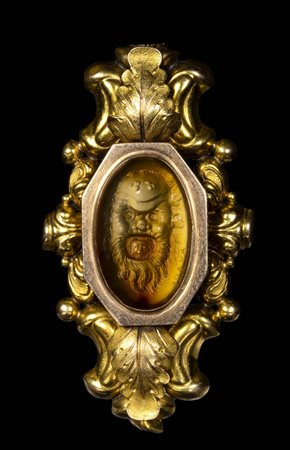 Bertolami Fine Art - Piazza Lovatelli 1, 00186 Roma
Bertolami Fine Art - Piazza Lovatelli 1, 00186 Roma
ASTA 267 - GLITTICA ASTA 267 - GLITTICA
venerdì 7 luglio 2023 ore 12:30 (UTC +00:00)
A FINE ANCIENT CARNELIAN INTAGLIO SIGNED AYLOY SET IN A GOLD BROOCH. A DIONYSIAC MASK WITH A GORGONA MASK INSIDE THE MOUTH.
A FINE ANCIENT CARNELIAN INTAGLIO SIGNED AYLOY SET IN A GOLD BROOCH. A DIONYSIAC MASK WITH A GORGONA MASK INSIDE THE MOUTH.
End of 1st century B.C. - Early 1st century A.D.
Stone 13x20 mm; Brooch 28x51 mm; 9.18 gr
This large intaglio is convex on both sides showing wear marks and light superficial scratches of ancient aspect. The mask of Silenus is deeply carved with a small frontal Medusa face inside the open mouth. The dionysiac mask is bearded, frontal, with the head adorned with a crown of ivy; it can be considered a comic mask. The eyes are rendered with a very clear circular engraved lines, the nose is large with globular elements, the thick and long beard engraved with fine and wavy lines to the right. This mask finds its best comparison both for the style, the iconography and the material with a Roman sard intaglio (always convex on both sides) depicting a double theatrical mask, Metropolitan Museum, New York. The eyes, brows, facial look, gaping mouth, beard, and in general the style, match. The intaglio is signed AVΛOY for Aulos on the bottom right. Aulos is considered to have been one of greatest gem engravers reported in ancient references to be in the employ of Augustus during the late 1st Century B.C. along with Dioscorides, Hyllos, and Solon. The Aulos signature can be found in several forms across a number of both ancient and neo-classical engraved gems.
Although it is difficult to know for certain, it is suspected that some of the Aulos signatures on ancient engraved gems may have also been added in the Renaissance or Neo-Classical period. However, The signature best compares to a convex amethyst intaglio with a Nereid on a seahorse, from the Sangiorgi Collection sold at Christies . It does not appear that this signature in particular has been excluded completely as a forgery, however, it has been subject to some debate in the scholarship (Boardman and Wagner (Masterpieces in miniature, p. 190) thought possibly original.“). Another close parallel for the style of the signature, see also the Marlborough gem n. 617 (n. 138), a rock crystal intaglio with an Erote holding a giant cornucopia, 1st century B.C. (Tassie 6607). This convex rock crystal from the Marlborough coll. was identified as possibly a genuine work of the engraver Aulos. The style and the model of that dyonisiac mask finds interesting others matches on gems and cast impressions with a similar subject, like from Paoletti, Cades and Tassie. For the signature style, see the comparisons. A further research is necessary. The gem is set in a beautiful gold brooch. The frame around the stone, octagonal in shape and pinkish in tone, seems to belong to an older and earlier setting than the addition of the ornamental part with leaves, in a different metal. Wear marks.
For parallels, see: G.M. A. Richter, Catalogue of the engraved gems. Greek-Etruscan-Roman. p. 119 n. 583. J. Boardman, C. Wagner, Masterpieces in miniature, p. 190. See also. L.P.B. Stefanelli, La Collezione Paoletti, vol. I, tomo Tomo II, n. 650 and 654; tomo IV, n 387; British Museum database for "masks"; KHM, red jasper intaglio with an erote putting is face on a large mask of Silenus ( Antikensammlung, IXb 526). Than, William Tassie red sulphur impression 1281 with a Beared Mask, Face (?) visible in the open mouth: Tassie 3884 - Lippert II 967 (Baron the Stain). Beazley Archive for the Marlborough gem 617 (138). See also the burnt intaglio set in a gold ring with Venus and Eros, British Museum with Tassie 6320; The Beverly gem n. 90 with a bust of young Hercules set in a gold ring; five intaglios identified in Philippe von Stosche's - Pierres Antiques Gravees published in 1724 which documented the known signed Aulos gems belived to be ancient at the time. Paralles can be do with Cades- Piombino Boncompagni e Tassie- Strozzi casts (Tassie 2119, 4083, 7896, 7614. Others interesting parallel for the style of the signature must be done with the intaglio showing a bull on a thyrsus signed by Hyllos, Paris, Cabinet des Medailles. G. Richter documents a group of gems by Aulos in the catalogue of the MET. Some others gems, but to be dated as Neoclassical, show an Aulos signature, but usually done with a different manner, like in a carthouche ( Tassie 4084 with the bust of Asclepius, attribuited to Antonio Pichler).
Provenance: Brooch setting suggests that the intaglio was mounted in Britain during the late 18th to early 19th century; U.S. private collection, acquired on the art market. This lot is sold under temporary import status.











